Centuries of fame have come the way of the delicate products created in Van Lam embroidery village.
Located at the entrance to the Tam Coc - Bich Dong Tourism Site in Ninh Hai Commune, Hoa Lu District, the village has long been a special destination for tourists to the province.
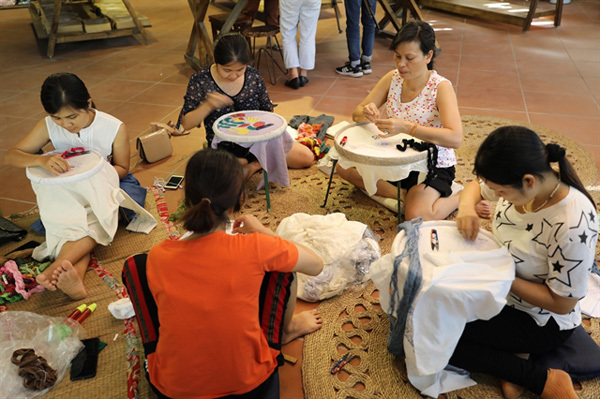 |
| Embroider artisans work in Minh Trang Company's showroom. |
Nguyen Van Hoat, chairman of the Ninh Hai Commune People’s Committee, said there are some 1,200 households with 3,000 people in Van Lam Village, many of whom have maintained its traditional craft.
“Children here begin to embroider at the age of seven and villagers of 80 can still hold a needle and thread,” he told Việt Nam News. “In the past few years many people have switched to offering tourism services to earn a better living but still work with the craft in some way.”
Local people say embroidery skills have been handed down through the generations for over 700 years.
During the Tran Dynasty (1225-1400), royal tutor Tran Thu Do (1194-1264) trained his army in the Ninh Binh area and his wife Tran Thi Dung (1193-1259) opened classes for people to learn how to embroider.
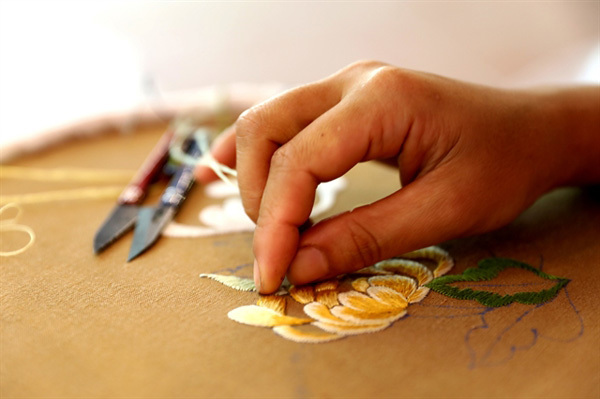 |
| Embroidering requires great skills and cares. |
Villagers then became specialists in embroidering royal costumes and costumes for rituals.
In 1910, under the French colonial time, brothers Dinh Ngoc Henh and Dinh Ngoc Xoan went to Hanoi to study French embroidery skills and then passed them on to the village folk.
The village's embroidery artisans have created more lace designs inspired by European tastes since then, according to artisan Vu Thi Hong Yen, owner of the Minh Trang Company.
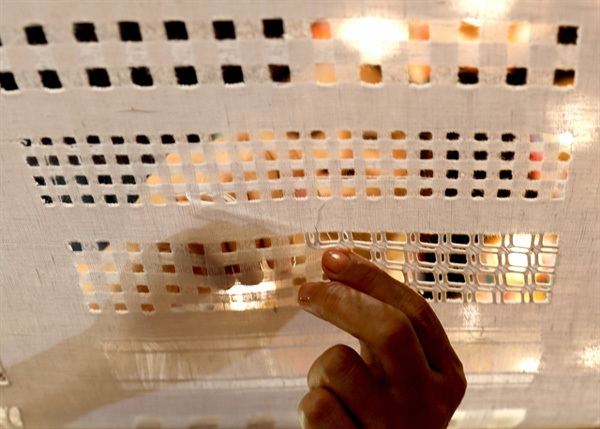 |
| Embroidering skills around holes, which has been learnt from French in early 20th century. |
The local embroidery craft has grown into a selection of thousands of different items, including bedsheets, curtains, tablecloths, placemats, and interior décor items.
The village is now home to nine companies and dozens of workshops gathering together 700 households in the craft. Revenue from the trade each year reaches some VND80-90 billion (US$3.4 million-3.8 million).
Chairman Hoat said that Van Lam was now also combining handicrafts with tourism.
“You can see it along the road leading to Tam Coc - Bich Dong, where there are dozens of shops offering embroidery of various types, like paintings, clothes, and household items,” he said.
Embroidery was recognised by the province as a traditional handicraft in 2006 and in November 2007 the Vietnam Handicraft Villages Association included Van Lam among 12 embroidery trade villages in the country.
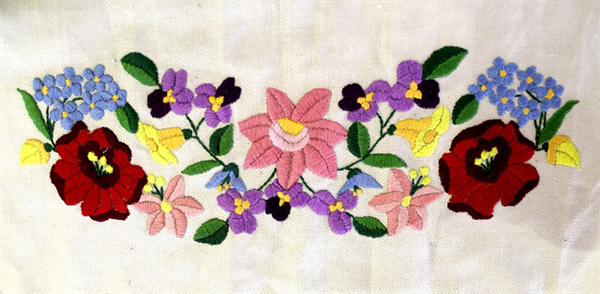 |
| Table cloth with embroidery patterns. |
Several village elders have earned the title “artisan”, including Chu Van Luong and Dinh Van Uynh, both of whom are over 80 years of age. Three local companies, meanwhile, have been praised for their services to the industry - Minh Trang, Pataco and An Loc.
“Our commune has introduced a policy of moving away from agriculture but not the homeland,” Hoat said. “Villagers have continued the craft in Van Lam while also offering tourism services.”
The province has set aside a large plot of land near Tam Coc - Bich Dong for a handicraft centre, where local people will be able to show off their embroidery skills and products.
Authorities, however, remain unsure of when the centre may open as there are still obstacles to address.
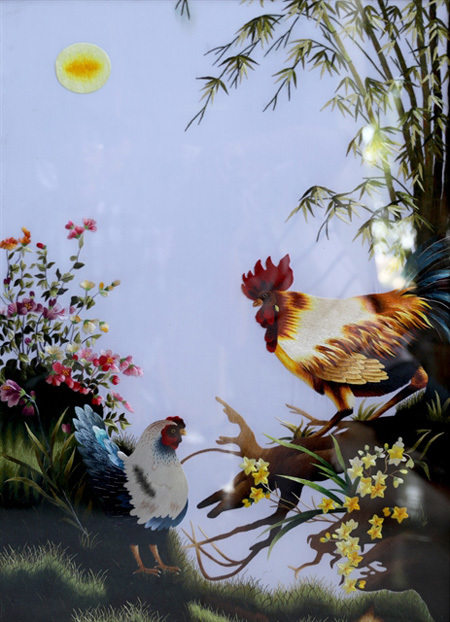 |
| An embroidery painting by artisan Vu Thanh Luan. |
Vu Thanh Luan, chairman of the village’s Artisans Association, has ten homestay rooms for guests, where they can experience local handicrafts as well as do sightseeing.
They can also try their hand at embroidering and take their creations home.
Maintaining tradition
Ninety per cent of Minh Trang company’s products are now for foreign markets.
“Our fashion items go to Japan, Australia and the UK, while our silk bedding products are sold in South Korea, France, and Spain,” owner Yen said.
A major challenge for the company is that many local people have moved away from tourism and sought jobs in industrial zones.
“We must maintain our team of experienced embroiderers and other skilled workers,” she explained. “If our young people leave, the craft will gradually disappear from our village.”
Her company has teamed up with a local vocational centre for several years to hold training classes for people, including the young, in other communes nearby.
The novel coronavirus outbreak, meanwhile, wreaked havoc on the industry, with overseas orders down by half.
“We have retained a skeleton staff to work on existing orders while we wait for brighter days,” Yen said.
One encouraging sign, however, is that more than a few people have taken up embroidery once again, having lost their jobs in tourism or at industrial zones during the social distancing measures introduced to tackle the pandemic.
“The traditional handicraft still has a role to play in our village,” she said. “It has given us a stable living and come to our rescue during the difficult days of COVID-19.”
She hopes the State and local authorities will be able to introduce policies favourable to companies like hers, so that they can continue to provide jobs while maintaining the culture and history of the area and the craft.
Dinh Thi Mai, who was born in the village and now runs a shop selling embroidery in Hang Gai Street in downtown Hanoi, said the artisans of Van Lam picked up techniques from the French but are now far superior in terms of designs.
“Many foreign customers place orders at my store and are surprised to receive goods that far exceed their expectations,” she said. “I’m very proud of the people in my homeland.”
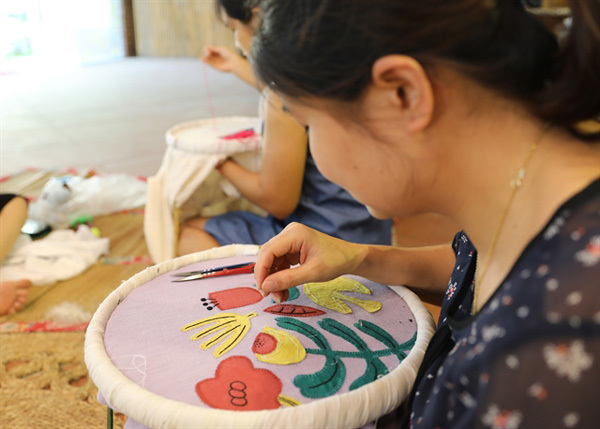 |
| Embroidery handicraft brings stable income to locals in Van Lam Village. VNS Photos Doan Tung |
After more than 20 years in the field, Luan feels fortunate to have been born into a family where a traditional handicraft is handed down.
His company’s products are mostly exported to Japan and France.
“Not being able to hand down the craft to the young of our village would be a great regret,” he said. “Our family continued to embroider even during the American bombings of North Vietnam, working under the light of oil lamps.”
The village’s products are more varied in form and artistic style than similar products from elsewhere, as the people of Van Lam combine traditional Vietnamese skills with French skills to make works of art.
“An artisan must have not only a good eye but also experience and passion to create striking products,” he said. “For example, in an embroidered painting of a rooster, the artisan must know where each coloured thread goes, how to make its feathers look shiny and colourful, and how to make its eyes brighter.”
The association, Luan said, is doing what it can to attract young people to the art so the tradition stays alive, like offering training courses, while tourism also represents a way forward. VNS
Le Huong & Ho Hoang
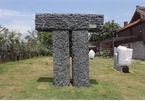
Artworks to be displayed in Ninh Binh
An exhibition featuring artworks that resulted from a creativity camp will begin at Tam Coc Centre in Hoa Lu District in the northern province of Ninh Bình today.

Festival features Tam Coc in golden rice fields
Tourists are being lured to enjoy the golden fields by the mountains of Hoa Lu District at the start of the Ninh Binh Tourism Week 2019 which kicked off on Saturday.
 The northern province of Ninh Binh is not only known as home of the UNESCO-recognised Trang An Tourism Complex but also as the birthplace of a whole host of talented people in the craft trade.
The northern province of Ninh Binh is not only known as home of the UNESCO-recognised Trang An Tourism Complex but also as the birthplace of a whole host of talented people in the craft trade.